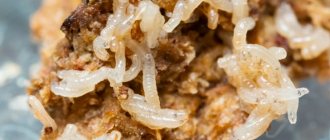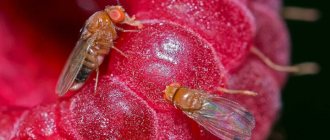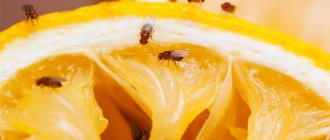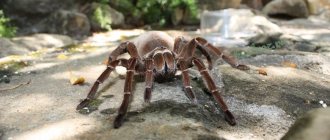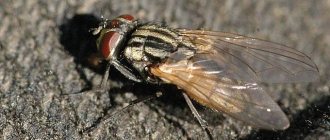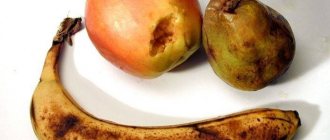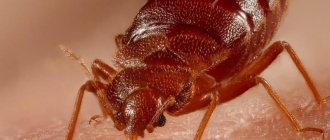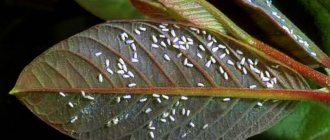Midges are a fairly common phenomenon that almost every housewife encounters. They appear indoors suddenly, so you need to know how long midges live and what measures to take to prevent their spread. The midge looks like an ordinary humpback mosquito. It reaches six millimeters in length, has short legs and a proboscis. At rest, the wings of an insect are folded one on top of the other. The segmented antennae have eleven sections.
Midges
Varieties
Experts classify varieties of midges depending on their habitat and favorite foods of insects:
- Sewer flies. They fly out of sewer pipes and sinks. Outwardly it may seem that they are “fluffy”. The inhabitants of shells are often called black midges for their dark color.
- Fungus small mosquitoes. These annoying creatures rummage through indoor flowers, causing damage to the soil.
- Clothes or food moth. Accordingly, the first lives in the wardrobe, and the second in the kitchen cabinets. These are real pests that cause serious damage.
- Nasty. These are very annoying midges that bite and try to fly into your eyes. The main thing is not to confuse them with mosquitoes.
- Drosophila are fruit flies or fruit flies. These are the safest insects when compared to those listed above, but they multiply quickly and can cause significant discomfort.
Attention! Fruit midges are dozens of species of insects that are practically indistinguishable in appearance. The average size of one individual is 1-3 mm, and you can recognize it by its “drunk” slow flight and oval body shape
The insect's body color can vary from dark yellow to brown, with black and orange being less common.
Onion midges - what kind of insects?
Midges are small flying insects with two wings that happily settle in human homes and feed on plant foods. In fact, the onion midge consumes not only onions, but also settles on other fruits, berries, and vegetables that are not stored properly in the apartment. There are several species of midges that live on plant products, and most often these are Drosophila (fruit flies) and scyriad soil midges.
You should not think that, apart from aesthetic harm, such small insects do not interfere with humans in any way. Even small midges are carriers of diseases. In people prone to allergies, their bites can cause severe skin reactions and swelling. These insects lay their eggs on food, the larvae emerge from them and immediately begin to feed intensively. Midges stain furniture, walls, and can even fly into a person’s mouth and nose.
Here are the main signs of midges that most often settle at home:
- Size – 1-3 mm
- Oval body
- Slow flight, not like a regular fly
- Six legs, two wings
- Yellowish, brown, black body color
ATTENTION: Whatever species the onion midge belongs to, in a very short period of time its colony will become numerous, because these pests reproduce extremely quickly.
Lifespan
The lifespan of midges largely depends on living conditions. Outdoors, larvae of this type of pest can appear when the air temperature warms up to +16 degrees.
Accordingly, the question arises at what temperature midges die. Adults, as well as their larvae, cannot tolerate low temperatures: if they come into contact with snow or ice outside, they can simply die. Therefore, small pests try to survive the cold season in a person’s home, settling in a trash bin or on a windowsill. Their life expectancy during this period increases to 50 days.
The easiest way to get rid of adult fruit flies and their larvae is to create unfavorable conditions for their habitat. First of all, it is necessary to remove, which can be a rotten fruit or vegetable. After all, knowing how long midges live without food, and how long they can live in starvation conditions for only a few days, getting rid of a swarm of midges using this method is quite quick and easy. If there is an excessive accumulation of insects, you can use pesticides, from which the insects will die en masse.
The lifespan of the midge, which pretty much begins to bother vacationers every summer, averages about a month. Insert it into the jar. This should be done with the tip down. This way, it will be easy for fruit flies to climb into the jar, but they will never get back out. Find the place where they are most concentrated. How long do fruit flies live? This is where they feel best.
Place traps in other places where they may accumulate.
However, strong winds and other weather factors significantly shorten their life outdoors.
20 days is the answer to the question of how long midges live on the street. It’s quite easy for them to find something to eat in garbage dumps.
Approximately 20 days. The most common place where they live is in vineyard plantations, because no one will fight the influx of such insects over vast areas.
The life cycle of a midge consists of laying and maturing eggs - this occurs under water and lasts about two weeks. The larvae and pupae of some species of midges use other aquatic arthropods, such as crabs and mayfly larvae, as a substrate. The second similar formation is located on the thoracic “leg” and serves to crawl along the substrate. In this case, most of the time the larvae are attached to the substrate (stones, aquatic plants, debris) by a special formation - a posterior attachment organ, consisting of many rows of hooks.
Place the jar in a visible place or near the insects' habitat.
Sometimes insects can live in a container that contains some kind of chemical, such as a paint can.
One fly lives in a warm room for a month, but their numbers can grow exponentially.
The midge, although small, is a rather unpleasant insect. How long do midges live in the kitchen? 35-45 days. Such a long period of residence is explained by a sufficient amount of food and a warm, well-lit room. How long do midges live in a trash can? Small colonies can live there for up to four months. Usually the larvae turn into full-fledged fruit midges in the early morning, so a lot of them accumulate in the first half of the day. Towards evening, the activity of annoying insects gradually fades away.
The most favorable habitat for midges is our apartments.
How long do midges live indoors when they have nothing to eat?
Even with short-term contact with snow and ice, the midge dies.
THUNDER 2…sprinkle a little soil in the pot, loosen it and water it…. Don't put vegetables in cabinets. Take inventory of your refrigerator and pantries regularly. Rinse your trash can even if you use bags. Wait for the fruit flies to fly and close the bag quickly. Take it to an outdoor trash container. Plastic bag. Take one garbage bag. Open it up as much as possible and place a few slices of fruit in the middle.
Sometimes even the smallest creature can cause a lot of trouble. In the modern world, there are more than 4,000 species and 78 genera of small midges. About 200 species are common in Russia, and only four of them feed on the blood of mammals.
flower midge
What do these little insects do, what harm do they cause, and what is their life expectancy? How much trouble the midge brings to humans and animals. Of the wide variety of complaints about midges, the following can be distinguished:
- their bites are very painful;
- spoil home and garden plants;
- can serve as a carrier of infection;
- in large quantities they get into the nose, ears, eyes.
What do fruit midges eat?
Such insects feed on absolutely all types of fruits, or rather, their rotten remains and other naturally processed products. Young individuals prefer to eat fresh fruit juice. It helps them grow faster and produce healthy larvae.
A common question is how long midges live in the summer. During the warm season, the average lifespan of a fruit fly is one month. In nature, due to the lack of fruits in the cold season, the fly can feed on the sap of trees, grass, flowers and leaves.
The insect lives in countries with warm tropical, subtropical or temperate climates. Some species of fruit flies can drink the blood of people or animals to support their life cycle.
How long do midges that feed on blood live? Approximately 20 days. The most common place for them to live is in vineyard plantations, because no one will fight the influx of such insects over vast areas. Plus, midges really love grapes.
How are indoor flowers treated?
If a fruit midge has attacked indoor plants, you should act immediately to prevent the flowers from wilting. Pests leave larvae on plant leaves. To completely eliminate insects, you will have to use a chemical like Dichlorvos, Raptor or Reid. You need to put the flower pot in a plastic bag (you can use trash bags), then spray the chemical directly into the soil and tie it tightly. Remove the plant after 6 hours. During this time, all insects in the soil and on the leaves of the indoor flower will die.
It is prohibited to spray the chemical on the leaves!
18 ways to get rid of midges in indoor flowers
How to prevent the reappearance of pests?
To prevent insects from settling in your house or apartment again, you need to take measures to repel them. Thus, onion midges cannot tolerate the smell of pine needles and basil. Therefore, you need to purchase essential oils of fir, pine, and basil, soak cotton wool in them and place them in places where vegetables are stored.
Insects do not like the smell of clove seasoning - it can be stuck into citrus fruits that are stored outside the refrigerator. Midges also react negatively to the aromas of ylang-ylang, patchouli, and verbena oils, so they can be dripped into aroma lamps and used regularly. Midges also cannot stand the smell of camphor, which, by the way, is absolutely not harmful to humans. Preventing the appearance of midges is not difficult, but it is effective, and an unpleasant neighborhood will most likely not happen to them.
See also: Methods for successfully combating onion midges
Midges are common insects that look harmless in appearance and appear suddenly in an apartment. They can be seen in indoor flowers or in the kitchen, when there are a lot of vegetables, berries and fruits. Annoying parasites cause a lot of discomfort to humans. They get into your eyes, mouth, and get into food and drinks on the table. Since midges breed quickly, after a few days a whole swarm of creatures appears.
DIY fly traps in the kitchen
There are a lot of types. Based on those described, you can even come up with several of your own designs.
Disposable cup trap
You can do it like this:
- Take a glass that contains sour cream, yogurt, etc. The main thing is that you don’t mind throwing it away later.
- Place midge bait on the bottom. This could be jelly, fruit juice, apple cider vinegar, or a piece of berry.
- Cover the glass with cling film and make a small hole in the top through which midges can get inside.
- Place the trap near a cluster of insects.
- Get rid of it when it becomes full of small insects.
At night, the glass should be placed in the kitchen.
Glass jar insect trap
It's quite easy to make:
- Take a regular glass jar.
- Roll a funnel out of paper to half the height of the glass vessel. There should be a small hole at the very end.
- Place bait on the bottom.
- Insert the funnel into the jar and secure it with tape.
The midges will fly inside, but they will not be able to crawl out.
If it’s a shame to throw away the jar after use, rinse the vessel thoroughly.
Trap from a solution with detergent
- Pour sugar syrup, jelly or other liquid treat for midges into a small container.
- Add a little (a few drops) of detergent.
- Place in places where insects gather. If they sit on the solution, they will drown in it.
Juice or nectar is poured into any container, which acts as a bait for insects.
Made with milk and black pepper
- Mix a quarter liter of milk with three tablespoons of black pepper.
- Add one and a half tablespoons of granulated sugar.
- Soak sheets of paper in the solution and hang them up. When sitting on it, the midges will die.
This effective method does cause some inconvenience.
From formaldehyde, water and milk
- Mix together 3 tablespoons of milk, 5 tablespoons of sweet water, one tablespoon of formaldehyde.
- Divide the resulting mixture into several containers.
- Place where there are the most insects.
Insects die from contact with such a solution.
How to get rid of wine midge
You need to start fighting midges as soon as you find them in the house to avoid their further reproduction. To do this you need:
- find sources of reproduction and get rid of them;
- clean the kitchen of all spoiled food and plant debris;
- check the condition of rags for washing floors and dishes;
- check if the water supply is clogged and remove the clog if there is one;
- fill the drain with a special product or cover it with soda, and then extinguish it with vinegar, to eliminate food residues that fruit flies love so much;
- if there are not a lot of midges, you can simply collect them with a vacuum cleaner;
- Having gotten rid of spoiled food supplies, thoroughly wipe the shelves in the cabinets with soapy water and then vinegar;
- in the case when midges are infested in house plants, it is necessary to reduce watering and water the soil with a weak solution of potassium permanganate, or with insecticides specially produced for the soil (Grom, Fitoverm, Karbofos), if this does not help, then the contaminated soil must be completely change;
- Garlic, lavender, and citrus fruits will help drive insects out of the house; their pungent smell repels insects;
- It is possible to smoke fruit flies; to do this, pour the crushed camphor into a frying pan and place it on the stove; when steam appears, carry the dishes through all rooms. This procedure is safe for humans and pets.
- Predatory plants that digest insects caught in their traps will help in the fight against midges. They are easy to care for, they are harmless to humans, but they cope effectively with fruit flies and other insects. In addition, it is quite interesting to observe the process of the plant hunting and capturing prey;
- if it is cold enough outside, then you can simply cool the room thoroughly by opening the windows and all kitchen cabinets; fruit flies are sensitive to temperature and will die from hypothermia;
- use homemade traps.
Homemade wine fly traps
One of the effective ways to combat midges is to use homemade traps, which can be prepared in the following ways:
- Pour juice, compote or put pieces of fruit into a glass jar, make a paper funnel with a small hole at the end and insert it into the jar, carefully sealing the joints with tape. Attracted by the smell, midges easily penetrate the jar, but they will not be able to crawl out.
- Place slices of aromatic fruit in a bag that does not have holes on the walls or bottom and leave it overnight. The next morning, quickly close it with flies and throw it away.
- You can also catch fruit flies by placing saucers with syrup or juice, a mixture of sugar and yeast, in places where they accumulate. Insects will gather above the saucers and drown in the bait.
- Take a plastic cup and put a piece of fruit in it. Cover the glass with cling film and make small holes in it. The midges will penetrate, but they will no longer be able to get out and they may be thrown out along with the trap.
- You can use sticky fly tape by hanging it and placing it near places where insects gather.
Getting rid of fruit gnats is not very difficult. And for this it is not at all necessary to use toxic substances - the simplest methods described in the article turn out to be the most effective. Once fruit flies leave your home, do not forget about preventive measures.
Prevention rules - how to prevent midges from appearing in your apartment in the future?
Preventing the appearance of midges in your home is very simple and clear. This -
- Compliance with hygiene rules for residential premises.
- Regular cleaning and trash removal.
- Regular cleaning of the trash can.
- cleaning siphons.
- Timely discarding of food that has begun to spoil.
Also, pungent and persistent odors are good for preventing midges. For example, the smell of garlic or geranium, camphor or incense, if they do not prevent the appearance of midges 100%, will significantly reduce the risk of their appearance.
These measures are guaranteed to rid your home of annoying, uninvited guests.
published on according to the materials
The entry was taken from the website.
Preventive recommendations
Although midges do not live long, in large numbers they are capable of clinging to all found products in a few minutes and contaminating horizontal and vertical surfaces. You can prevent the appearance of pests if you follow preventive measures:
- There should be no food left on the table or plates. All leftover food must be thrown into the trash.
- Fermented garbage in a bucket can become a source of insects, so it should be taken out more often. The kitchen bucket should always be covered.
- An ideal place for insects to breed is drink bottles, cans, cups. All containers must be washed on time.
- To prevent vegetables and fruits from spoiling, they are stored in a cool place. They are regularly checked for rotting and all spoiled food is thrown away.
The first thing to do if midges are already flying around the apartment is to find the source of their reproduction, remove and thoroughly wash everything around.
Onions and garlic are unpretentious and can grow even with minimal care. But it should be remembered that the most dangerous pest for them is the onion fly. It is not easy to detect, so you need to pay attention to the appearance of the plants. The fight against onion fly is a simple process, but it must be started immediately after detecting the first signs of damage to the plantings.
How and where do midges develop and where do they come from?
Flies develop in places where there has been no cleaning for a long time. But the question still arises: how do they reproduce? After all, their development comes from conception. Even if you clean on time and do general cleaning (at least every day), as soon as some fruit spoils, this midge is right there. How does this happen?
If you take some steps, midges may not appear in the kitchen.
- All fruits, before putting them in a vase
, must be thoroughly washed and dried, since wet fruits are more susceptible to spoilage and rot. - It is best to wash the fruit with hot water
or pour boiling water over it, which will destroy all larvae, if any.
Rotten, damaged or too soft plums, apricots, apples, pears and other fruits must be removed from the fruit bowl in a timely manner- Berries and fruits that spoil quickly
: raspberries, strawberries, cherries and other berries should not be placed on the table for a long time - they should be eaten quickly. The same should be done with chopped and peeled fruits - pineapple, watermelon, melon, banana. - The best way is to put the fruit in the refrigerator overnight
. Preventing the appearance of midges is always easier than fighting it later.
To finally get rid of midges, you need to know the exact cause of their occurrence. Sometimes it happens that no methods help. In such cases, only special chemicals can help, which need to be used to treat the entire room. And after that, never leave fruits, vegetables, berries and other foods on the table overnight.
How to get rid of midges?
When you bring the purchased fruit home, you need to rinse it thoroughly or pour boiling water over it (then the midge eggs will die) and put it in the refrigerator. These insects do not reproduce in the cold
. If some fruit has rotted somewhere, you need to immediately get rid of it and immediately wash the place where it was located.
Be sure to frequently check the places where food is stored:
- potato;
- carrot;
- onions, etc.
It is important to clean them from possible rotting. When watering indoor plants, you should not get carried away by saturating the soil too much with water.
Garbage bags and buckets should not be stored for a long time, as garbage tends to deteriorate.
, and from here the appearance of midges only increases.
If you follow these rules, then you don’t have to use chemicals - the midges themselves will disappear without even appearing.
What to do if you find onion midges?
How to get rid of onion midges is a paramount question, and you need to start solving it by finding a place for their active reproduction. The main thing is to leave pests without food and a breeding ground for their offspring. The procedure will be as follows:
- Throw away spoiled onions, carefully sorting through all available vegetables.
- Place the onions in the refrigerator without signs of rotting or spoilage, placing them in small portions in plastic bags.
- If it is not possible to put onions and other root vegetables in the cold, they should be stored in boxes with sawdust, or, as a last resort, in well-ventilated fabric bags.
- Remove all fruits, especially citrus fruits, out of reach of midges.
- Throw out garbage on time, at first - 1-2 times a day.
- Wash dirty dishes immediately after eating.
- Limit the access of insects to water - they also need it for life. To do this, you should close all taps so that they do not drip, leave sinks dry, do not store water on the table, and thoroughly dry clean dishes.
- Remove and clean siphons a couple of times a week and use disinfectants to clean the sewer system.
- Wash your pets' cages regularly and prevent food residues from being left there.
IMPORTANT: If there are plants in the apartment, they also need to be cleaned, because insects can settle on them for lack of other food. You should reduce the frequency of watering and stop pouring tea leaves on the ground. If necessary, you can spray the flowers with a weak solution of potassium permanganate.
Tips to help you quickly get rid of onion midges:
Description of midges
Varieties
There are many varieties, but there are not many species that live in human homes. The most common types of midges are:
Drosophila. Another name is fruit gnats. The most common type in the apartment. Don't confuse them with fruit flies. Although they look very similar, they are different types of insects. They have an oval-shaped body, usually brown or yellowish in color. They are quite small - they reach 2-4 mm in length. As the name implies, they feed on fruits, most often rotten ones, and other food debris; they like to enjoy fermented juice or compote, as well as wine residues, which is why they are also called wine midges. They can often be found in the kitchen, in the basement where food is stored, near the trash heap.
Drosophila midge
butterfly fly. They are sometimes called sewer midges. Externally they are very similar to night moths. They have gray wings covered with small villi, antennae, body and paws are also covered with villi. The length of the body is 1-4 mm. They live near sewers - near sinks, toilets and other drainage holes. They feed mainly on rotten organic waste.
Butterfly
sciarids. Also called floral, mushroom or forest. The body is dark in color, slightly larger in size than previous species - reaching 2-7 mm in length. Midges often appear on windows, but they live in flower pots if the housewife waters them too often and too much, or when she uses tea leaves as watering.
Sciarida
Life cycle
The lifespan of individuals depends on the ambient temperature and the availability of food. So, at a temperature of about 25 degrees, life expectancy will be about 10 days, at a temperature of about 18 degrees - more than 2 weeks. Further, the lower the temperature, the shorter their life expectancy will be. In the absence of food, the individual can live only a few days.
The female lays small eggs (about 0.5 mm long) in the pulp of fruits or any other leftover food. A day later, larvae emerge from the eggs. For several days they grow, feeding on rotting fruit pulp and microorganisms developing in it. During this time, they molt twice - one day after hatching from the egg and another day after the first molt. After 5 days from the moment of hatching, the larvae pupate and after another 5 days an adult emerges from the pupa. Sexual maturity of females occurs within 12 hours after the pupal stage.
Causes of midges
The main reason for the appearance of pests in the house is the uncleanliness of the owners; cases of the spread of midges are no exception. As we already know, the main food for them is rotting food remains, mainly fruits, fermented juice, compote or syrup, and other organic waste. From this we can conclude that such things in the house are very attractive to fruit flies. Lack of regular cleaning, unventilated premises, and too high humidity greatly increase the chances of unwanted neighbors appearing in the house. And regularly overwatering indoor plants or throwing leftover tea into pots increases the risk of sciarids.
Since midges live in unsanitary places, such as garbage dumps, garbage chutes, sewers, where many pathogenic bacteria develop, individuals can easily transfer them to ordinary food. In this case, a person can become infected with dangerous infections, in particular through a midge bite. In the case of sciarids that live in flower pots, diseases, fungus and mites can spread to all indoor plants.
Appearance
It is worth saying that the structure of a midge is practically no different from an ordinary large fly. The head on which the eyes, mandibles and antennae are located. The head and abdomen are connected by a prothorax. There is an abdomen, genitals, a haltere, 2 wings and 3 pairs of legs. But each type has its own characteristics.
Sciarids grow to a size of no more than 4 mm. They have a dark brown or black body color, and the 2nd lid is completely transparent. Outwardly, they are very similar to small mosquitoes.
The butterfly has a hairy body measuring 1-4 mm and can be gray or dark brown in color. It is also distinguished by jagged antennae and rounded, spaced wings. Drosophila midges have a red striped body and red eyes, the abdomen of males is 2.5 mm long, in females it is smaller and also much darker. Transparent wings have a beige tint.
Whiteflies look a lot like moths that have been dusted with flour, but they are actually waxy pollen. It has a yellow body and very long antennae. Some representatives have barely noticeable brown spots on the abdomen.
There are 2 pairs of wings, opaque, white, they fold one above the other. The size of an adult dace is 2-3 mm. They often accumulate on the underside of leaf blades. If you move the plant, you can see a flock of midges rising up. These individuals can not only fly, but also jump.
Chemicals and devices
Using products designed for pest control is the most logical answer to the question of how to get rid of small midges in the house. Such drugs, designed to quickly solve the problem, are produced in a wide range.
Aerosols, sprays
These products are used to combat other winged insects - mosquitoes, flies, moths, wasps. However, they effectively eliminate flying “trifles”. The most famous mosquito repellents include Bona Forte, Combat Super Spray, Raid, Hexachloran, Dichlorvos and Dichlorvos Neo, Raptor.
Before using the product, remove all food and containers (for example, teapots). All pets, including aquarium pets, are removed from the premises. All household members go outside. In the rooms, close the windows and doors, then spray the drug into the air, treat all corners of the room with it, not forgetting the cracks.
After treatment, the apartment is left for the period prescribed by the manufacturer. Then the rooms are well ventilated, all rooms are wet cleaned, removing midges from all surfaces. If you skip this step, the pests will “come to their senses” after a while, so the owners will have to do the procedure again.
Repellents
This option will appeal to those owners who don’t really like the words “harassment” or “destruction.” These drugs do not kill insects, but they force them to quickly leave the room.
In this case, the treatment is also carried out in closed rooms, and flying “living creatures” will begin to escape already during ventilation. There are many forms of repellents. Popular preparations are aerosols, pencils, creams and lotions, ointments or emulsions. There are coils that need to be ignited, and devices that constantly release the active substance.
Since for large rooms, local treatment with pencils or creams does not guarantee results, it is recommended to use more reliable preparations. These include aerosols, spirals and other repellers that can create a strong concentration of the active substance.
Fumigators
These devices are familiar to everyone who constantly flees from another flying threat - from “squeaky” mosquitoes. Fumigators are electrical appliances equipped with a heating element. With its help, insecticides that insects are afraid of evaporate. The devices are produced in two types - liquid and plate.
The first devices “work” with a toxic solution placed in a transparent container. It is attached to the fumigator from below. Such vessels are enough for about a month of daily (or rather, nightly) use.
In the second means, plates are impregnated with a toxic liquid, which are inserted into a special compartment of the fumigator. This form gets rid of annoying insects for a period of 8 to 10 hours. The drugs act in the same way on small midges.
Light traps-night lights
This is another type of effective means, the work of which is easy to notice in the dark, since all the insects fly towards the light. The operating principle of such devices is simple: midges flying towards the ultraviolet lamp-sun encounter an electric discharge. These devices are deadly to insects, but they are completely safe for people and pets.
The disadvantage of using light traps may seem serious to some. This is the sound that appears when a midge comes into contact with a light source - a crackling sound with each discharge of current. If there are quite a lot of insects, then such “music” can become an additional, nighttime irritant for household members.
How to make midge traps?
Onion midges sometimes multiply on such a scale that simply getting rid of rotting vegetables does not bring proper and quick results. In this case, the hostess will have to take a number of more radical measures to get rid of uninvited guests. How to make baits with your own hands where insects will die? Here are good ways:
- Take a 0.5 liter plastic disposable glass, throw a piece of fruit into the bottom or pour a little sweet juice (compote). Wrap the glass in cling film, making several small holes in it. Leave the trap in the kitchen overnight, quickly put the glass in a tight bag in the morning and take it out of the house.
- Pour juice into the bottom of the jar or put overripe fruit, cut into slices. Cover the top of the jar with a paper funnel, placing its narrow side inward. Leave the jar on the table at night, pour water into it in the morning - all the midges will die.
- Pour water into a flat plate, drop a little citrus-scented dishwashing detergent into the water. The insects will land on the water, but will no longer be able to take off.
You can also get rid of flies using medications. Nowadays, any store sells special adhesive tapes and sheets to which harmful insects quickly stick. It is not recommended to use aerosols and other chemicals, because their residues can end up on the table or in food, causing harm to humans. But ventilating the apartment and mechanically removing pests using a towel through the window, or sucking them up with a vacuum cleaner will definitely not do any harm and are perfect as one of a set of measures to combat midges.
Reasons for the appearance of midges in the house
Until you find out why these small insects appeared in your home, you will not be able to completely remove them.
The appearance of midges is associated with the following factors:
With irregular cleaning of the trash can, delay in taking it out. The temperature and especially humidity in a garbage heap with organic waste is slightly higher than in the environment. The remains of vegetables rot, midges begin to multiply. They notice insects when they are already flying everywhere. Often, midge eggs are laid on the walls and bottom of the bucket, and if it is not washed periodically, the insects will also begin to actively reproduce.
In most cases, insects breed in rotting environments.
With unwashed fruits and vegetables from the garden or store. Many people believe (and not without reason) that the harvest from their own garden is the best, without nitrates, etc. They don’t wash the fruits right away, they begin to spoil. As a result, midges appear. The same thing happens due to lack of time or simply laziness with vegetables and fruits purchased at the nearest market or store.
Dirty or spoiled fruit.
With rotting of the roots of indoor plants. This happens when the latter are watered abundantly. Any soil that is not sterilized contains midge eggs. As soon as a nutrient medium appears, small parasites immediately begin to multiply.
Flower plants. Midges appear in pots due to excess moisture.
With improper fertilization of house plants. Tea is often used for the latter. The midges love him very much.
They parasitize house plants, inhibiting their growth.
With placing indoor plants on the balcony. Insects can come from the street. Therefore, if you have already placed pots of flowers there, check them as often as possible.
With irregular cleaning of the tray and the habitat of pets, especially rabbits, hamsters and guinea pigs.
There is always organic matter there; if you don’t clean it out regularly, it rots.
With improper care of the aquarium. Algae can also decompose. In addition, fish require moderately warm water.
These are ideal conditions for the appearance of rot, and therefore midges.
With clogged water supply and sewer systems. First of all, with siphons for sinks and toilets. Residues of food settle at the bottom, and if not cleaned in a timely manner, they rot. The result is not difficult to predict.
Malfunction of the sewer system or other communications, leaking pipes.
Methods of destruction
Annoying parasites can be destroyed using folk methods or professional medications. To completely get rid of them, the procedure is carried out strictly according to the instructions, regardless of the chosen product.
Traditional methods
There are many folk remedies, the most popular of them:
- Vacuum cleaner . If a large number of insects have accumulated in one place, a container with vegetables, bags or other containers, they can be easily removed using a vacuum cleaner. The device is turned on at full power, sucking fruit flies inside. The vacuum cleaner bag is then cleaned outside the home.
- Camphor A. Insects cannot tolerate the smell of camphor. A small piece of camphor is ground and placed in a hot pan. Then the entire room is smoked with the resulting steam. You can replace camphor with verbena or clove oil. This method is good to use if there are small children living in the house.
- Water . To get rid of sewer gnats, insert a hose under the sink, then turn on strong water pressure. You can first add any anti-clogging agent.
- Cup trap . A small glass is cut out of a plastic bottle. A sweet drink is poured into it or pieces of fruit are placed. Then cover hermetically with cling film. Use a knife to make several holes in the film. The container is left overnight, and any parasites are thrown out in the morning.
Using such methods, you can destroy flying flies, but the larvae and eggs will remain untouched, so after a while they will again breed in the kitchen.
Chemicals
Industrial insecticides will help exterminate not only flies, but also their eggs and larvae. Before you start processing, you should put on a mask and gloves. The most effective drugs:
- Swissino trap . This is a compact trap with bait inside. Once the insects get inside, they won’t be able to fly back out. The range of the device is up to 30 m². The device is durable and completely safe for people living in the house.
- Electric trap "MOEL Fan" . The device is designed to repel flies, but works well against midges. It is equipped with a UV lamp, which attracts insects with its warmth. They are sucked into the fan, where they are killed by an electrical discharge. The device operates within a radius of up to 20 m². The cost of the trap is high.
- Aquafumigator "Ra >How to protect yourself from insects outdoors
You can scare away midges from a person using 2 means: repellents applied directly to the skin and fumigators - acting at a certain distance. Action of drugs:
- Repellents . The substances are produced in the form of ointments, lotions and sprays. They can be applied to both skin and clothing. Repellents act on the olfactory receptors of insects, effectively repelling them. Their effect lasts for 4–9 hours. This includes: “Help” aerosol, “Gardex”, “Mosquitall” ointment.
- Fumigators . Midges die due to the toxic substances included in the drug. They are released into the air when the device heats up. Fumigators are either pyrotechnic or electric. In nature, it is recommended to use spiral devices. Their disadvantage: small range.
Instead of chemical protective agents against midges, you can use a tincture based on an aromatic herb. Eucalyptus, wormwood leaves, and parsley are suitable for this. The selected plant is infused in vegetable oil for 3 weeks. The prepared solution is filtered and applied to exposed areas of the body.
Why do midges appear on seedlings?
The main reason for the appearance of insects is excessive soil moisture. This especially often happens on a cold windowsill in the absence of air circulation. Stagnant cold air and densely sown seedlings always only aggravate the situation. Wet, cold soil is an ideal place for midges to lay eggs. A little later, larvae develop from the eggs, which cause harm to the plants, readily feeding on the roots.
Insects can be introduced with purchased soil. Moreover, this is often noticed only when the insects have noticeably multiplied. And everything happened because the soil was not disinfected before planting.
Another reason is the use of infusions of liquid organic fertilizers prepared independently for feeding seedlings.
It is also impossible not to mention the presence of indoor plants on which midges have already settled. Insects quickly move to young shoots, and then lay their eggs in the soil underneath, from which larvae later emerge.
Chemicals
Onion fly can be combated in a more radical way - using chemicals. They are more harmful than traditional ones, but more effective. There are a large number of preparations that can be used to spray onions.
Onion midge and its larva
Among them:
Aktara insect repellent
- Aktara;
- Fly eater;
- Karate Zeon;
- Terradox;
- Maksim.
They are usually used on large areas of bulbous plants in large farms.
Based on their action, drugs are divided into:
- organic compounds – neonicotinoids;
- synthetic insecticides – pyrethroids.
The action of insecticides is to damage the nervous system with the development of paralysis and death of the insect. These types of products are not phytotoxic. Pyrethroids can only be used to kill adults.
